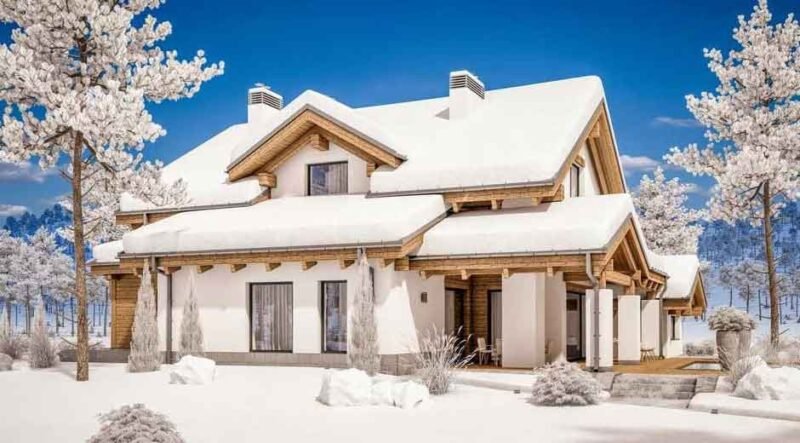
Winter can be unforgiving on your home’s structure and systems. With just a bit of advance planning you can protect your property, reduce repair costs, and keep your family comfortable through the cold months. Taking a few smart steps now makes it easier to relax when the first snow falls, knowing your house is winter-ready.
Seal Drafts and Keep Warmth Inside
Air leaks around windows, doors, and even electrical outlets allow precious heat to escape and cold air to enter. Start by walking every room’s perimeter, feeling for drafts with your hand or a lit candle. Apply caulk to cracks in window frames, door jambs, and baseboards. Install foam gasket seals behind outlet and switch plates on exterior walls. Add door sweeps under all exterior doors and self-adhesive weather stripping around door edges. Close gaps around attic hatches with insulated covers. By tightening your home’s envelope, you’ll reduce heating costs and maintain a more consistent indoor temperature.
Protect Your Plumbing from Freezing
Frozen pipes can burst and cause serious water damage. To prevent that, wrap exposed water lines in the basement, crawl space, garage, and unheated closets using foam insulation sleeves or heat tape. Shut off and drain exterior faucets, then store hoses indoors. For indoor pipes vulnerable to cold, leave cabinet doors open so warm air circulates around plumbing. Keep the thermostat set to at least 55 degrees on freezing nights. If a pipe does freeze, never use an open flame; instead apply gentle heat with a hair dryer or heating pad. Regular inspections of the water meter for unexpected drops can alert you to hidden leaks before they worsen.
Inspect and Maintain Your Roof
Your roof is the first line of defense against snow, ice, and wind-driven rain. In early fall, climb a ladder or hire a professional to look for damaged or missing shingles, cracked flashing around vents, and gaps around chimneys. Clear gutters and downspouts of leaves, twigs, and debris so melting snow drains freely and cannot form ice dams that back up under shingles. Inside the attic check for signs of leaks, mold, or inadequate insulation. Adding extra insulation to attic floors prevents heat from melting snow on the roof and causing ice buildup. If you’re not comfortable on a roof, scheduling a pre-winter roof inspection with a qualified roofer can catch problems before they turn into costly repairs.
Strengthen Your Home’s Exterior
Siding, trim, and foundation cracks all allow moisture to penetrate and lead to rot or mold growth. Walk your home’s perimeter looking for gaps, holes, or damaged materials. Repair or replace rotted wood trim, seal cracks in masonry with exterior-grade caulk, and touch up paint to protect surfaces from moisture. If you live in Colorado, for example, you might hire a James Hardie siding contractor in Denver to replace old or damaged siding with fiber cement panels that resist moisture, wind, and temperature swings. Solid, well-maintained exterior cladding not only keeps out the elements but also enhances your home’s curb appeal.
Protect Outdoor Spaces Before the Freeze
Winter can be brutal on decks, patios, and yard furniture. Clear outdoor surfaces of fallen leaves and debris to prevent mold and rot. Drain water from garden hoses, lawn sprinklers, and water features before temperatures drop. Cover grills with a weatherproof tarp or move them into a garage or shed. Stack patio cushions indoors and coat wooden furniture or decking with a water-repellent finish. Storing pots, tools, and lightweight decor in a secure shed prevents damage and reduces winter cleanup when spring arrives.
Service Your Heating System
A properly functioning heating system is critical for comfort and safety. Before cold weather arrives, change furnace filters and arrange for a professional HVAC technician to inspect, clean, and tune your furnace or boiler. Bleed radiators to remove trapped air and check vents for dust buildup. If you use a fireplace or wood stove install a chimney cap to keep out wildlife and creosote buildup. Test your programmable thermostat to ensure it keeps your house at the right temperature throughout the day. Regular maintenance not only improves energy efficiency but also extends the lifespan of your heating equipment.
Trim Trees and Clear Walkways
Snow-laden branches can snap and damage your roof, vehicles, or power lines. Prune dead or overhanging limbs well before heavy snow arrives. Remove loose branches and haul away yard waste. Stock up on deicing salt or sand and place it near entry points for quick access after a snowstorm. Keep walkways and driveways clear by storing shovels and snow blowers in an easily accessible spot. A safe, slip-free path to your door reduces the risk of falls and injuries when winter conditions worsen.
Check Safety Equipment for Winter Readiness
The increased use of heating appliances raises the risk of fire and carbon monoxide poisoning. Test smoke detectors and carbon monoxide alarms, replacing batteries as needed. Keep a fire extinguisher on every level of your home, and make sure it is fully charged and within reach. Create an emergency kit stocked with flashlights, extra batteries, warm blankets, nonperishable food, bottled water, and a first aid kit. If power outages are common in your area, consider adding a portable generator and fuel supply, following manufacturer instructions for safe operation.
Conclusion
Winter does not have to catch you off guard. By sealing drafts, protecting pipes, inspecting your roof, reinforcing your exterior, and winterizing outdoor spaces and heating systems, you set your home up for success. Pruning trees, clearing walkways, and verifying safety equipment further safeguard your property and loved ones. A bit of effort in fall yields peace of mind when snow and ice arrive. Take action now to enjoy a cozy, damage-free winter season and free yourself to savor holiday gatherings without unexpected home emergencies.

